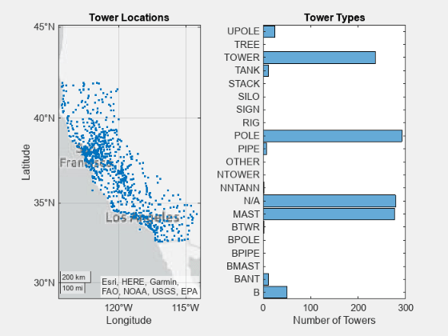创建包含极坐标区、地理坐标区或多个坐标区的图
对于作为 ChartContainer 基类的子类创建的图,getAxes 方法提供了一种方法来支持单个笛卡尔坐标区对象。如果要支持极坐标区、地理坐标区或多个坐标区,必须创建这些坐标区并将其配置为 TiledChartLayout 对象(该对象存储在图对象中)的子对象。
创建单个极坐标区或地理坐标区对象
要在图中包含单个极坐标区或地理坐标区对象:
定义一个私有属性来存储坐标区。
在
setup方法中:
例如,下面是一个包含极坐标区对象的基本类。
classdef SimplePolar < matlab.graphics.chartcontainer.ChartContainer properties(Access = private,Transient,NonCopyable) PolarAx matlab.graphics.axis.PolarAxes end methods(Access = protected) function setup(obj) % Get the layout and create the axes tcl = getLayout(obj); obj.PolarAx = polaraxes(tcl); % Other setup code % ... end function update(obj) % Update the chart % ... end end end
创建多个坐标区对象的分块
要显示多个坐标区的分块,请:
定义存储坐标区对象的私有属性。您还可以定义一个属性,用于存储坐标区对象数组。
在
setup方法中:
例如,以下是一个包含两个笛卡尔坐标区的基本类:
classdef TwoAxesChart < matlab.graphics.chartcontainer.ChartContainer properties(Access = private,Transient,NonCopyable) Ax1 matlab.graphics.axis.Axes Ax2 matlab.graphics.axis.Axes end methods(Access = protected) function setup(obj) % Get the layout and set the grid size tcl = getLayout(obj); tcl.GridSize = [2 1]; % Create the axes obj.Ax1 = axes(tcl); obj.Ax2 = axes(tcl); % Move the second axes to the second tile obj.Ax2.Layout.Tile = 2; end function update(obj) % Update the chart % ... end end end
示例:包含地理坐标区和笛卡尔坐标区的图
以下示例说明了如何定义一个图类,以使用两个坐标区可视化地理和分类数据。左侧坐标区包含一幅地图,显示了多个蜂窝塔的位置。右侧坐标区按类别显示了这些塔的分布情况。
以下 TowerChart 类定义显示了如何:
定义一个名为
TowerData的用于存储表的公共属性。使用一个名为
mustHaveRequiredVariables的局部函数验证表的内容。定义两个私有属性
MapAxes和HistogramAxes,用于存储坐标区。实现
setup方法,用于获取TiledChartLayout对象,指定布局的网格大小,以及定位坐标区。
要定义该类,请将以下代码复制到编辑器中,并将其以名称 TowerChart.m 保存在可写文件夹中。
classdef TowerChart < matlab.graphics.chartcontainer.ChartContainer properties TowerData (:,:) table {mustHaveRequiredVariables} = table([],... [],[],'VariableNames',{'STRUCTYPE','Latitude','Longitude'}) end properties (Access = private,Transient,NonCopyable) MapAxes matlab.graphics.axis.GeographicAxes HistogramAxes matlab.graphics.axis.Axes ScatterObject matlab.graphics.chart.primitive.Scatter HistogramObject matlab.graphics.chart.primitive.categorical.Histogram end methods (Access = protected) function setup(obj) % Configure layout and create axes tcl = getLayout(obj); tcl.GridSize = [1 2]; obj.MapAxes = geoaxes(tcl); obj.HistogramAxes = axes(tcl); % Move histogram axes to second tile obj.HistogramAxes.Layout.Tile = 2; % Create Scatter and Histogram objects obj.ScatterObject = geoscatter(obj.MapAxes,NaN,NaN,'.'); obj.HistogramObject = histogram(obj.HistogramAxes,categorical.empty,... 'Orientation','horizontal'); % Add titles to the axes title(obj.MapAxes,"Tower Locations") title(obj.HistogramAxes,"Tower Types") xlabel(obj.HistogramAxes,"Number of Towers") end function update(obj) % Update Scatter object obj.ScatterObject.LatitudeData = obj.TowerData.Latitude; obj.ScatterObject.LongitudeData = obj.TowerData.Longitude; % Get tower types from STRUCTYPE table variable towertypes = obj.TowerData.STRUCTYPE; % Check for empty towertypes before updating histogram if ~isempty(towertypes) obj.HistogramObject.Data = towertypes; obj.HistogramObject.Categories = categories(towertypes); else obj.HistogramObject.Data = categorical.empty; end end end end function mustHaveRequiredVariables(tbl) % Return error if table does not have required variables assert(all(ismember({'STRUCTYPE','Latitude','Longitude'},... tbl.Properties.VariableNames)),... 'MATLAB:TowerChart:InvalidTable',... 'Table must have STRUCTYPE, Latitude, and Longitude variables.'); end
保存类文件后,加载 cellularTowers.mat 中存储的表。然后通过将该表作为名称-值对组参量传递给 TowerChart 构造函数方法来创建图实例。
load cellularTowers.mat TowerChart('TowerData',cellularTowers);
